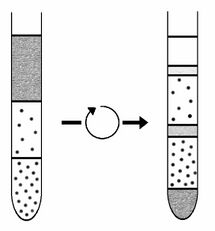Isolation of cells
Isolation of cells[edit | edit source]
The first condition for establishing a tissue culture is the isolation of the cells that will be grown. The starting material is usually an organ sterilely removed from an experimental animal, more rarely a biopsy sample or, for example, a bone marrow puncture or a peripheral blood sample .
If the starting material is a solid organ , there are basically two ways to create a cell culture from it:
- the tissue is cut into small particles that are immersed in the culture medium. The cells then grow out of the particles and spread over the surface of the culture vessel
- the tissue is broken up into individual cells, either mechanically with a homogenizer or – more gently – e.g. by enzymatic digestion (trypsin, collagenase, pronase, dispase, elastase, etc.).
Both methods, however, create a mixture of many cell types, from which the desired subpopulation must be isolated. Either the different resistance of individual cell types to different conditions, their demands on the composition of the culture medium, sensitivity to toxic substances, etc. can be used, or the cells can be divided according to their physical properties, most often according to density or sedimentation rate .
To isolate cells according to density ( isopycnic sedimentation ), centrifugation of a cell suspension in a test tube filled with a medium that has a different density at different distances from the bottom is used - the so-called division on a density gradient . The gradient density can be varied:
- be smooth ( continuous gradients )
- by jump ( discontinuous gradients ).
Creating continuous gradients[edit | edit source]
To create a continuous gradient , silica particles coated with polyvinyl-pyrrolidone (trade name Percoll® ) are most often used today. If a mixture of particles of different sizes is centrifuged at high speeds, they are separated by density . The medium at the bottom of the test tube then has a higher density than the medium at the surface. A cell suspension is applied to the surface of the gradient and the entire column is centrifuged again, this time at a significantly lower speed. The cells will drop down to a level where they have the same density as the medium. By removing an appropriate portion of the column, one particular cell type can be isolated. Another way to prepare a continuous gradient is to gradually mix two solutions, one with a higher and the other with a lower density, while the ratio of the two solutions changes continuously and the resulting mixture is filled with a centrifuge tube .
Creating discontinuous gradients[edit | edit source]
Technically simpler is the preparation of discontinuous gradients . In this case, solutions of different densities are simply layered on top of each other. The next layer is again the cell suspension. After centrifugation , the cells are partitioned between the individual solution interfaces such that each cell type remains between a solution of higher and lower density than the cell density. A variety of chemicals are used to prepare discontinuous gradients. The most common are carbohydrates , from readily available sucrose to polysaccharides (e.g. a multi-branched copolymer of sucrose and epichlorohydrin with a precisely defined molecular weight, trade name Ficoll® ).
Links[edit | edit source]
Source[edit | edit source]
- VEJRAŽKA, Martin. Basic techniques of working with tissue cultures [lecture on the subject Biochemistry, field of General Medicine, 1st Faculty of Medicine, UK]. Prague. 2004.


